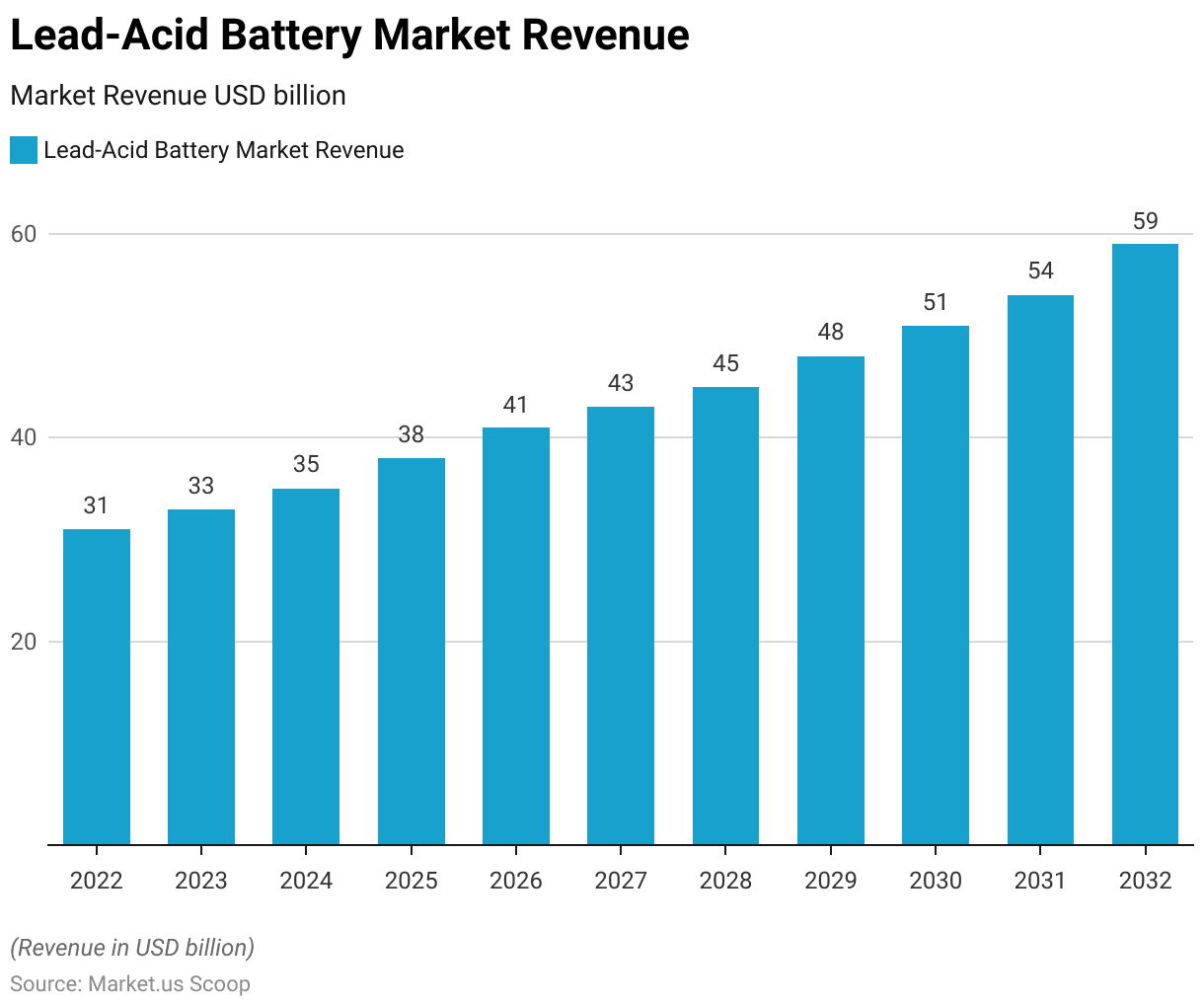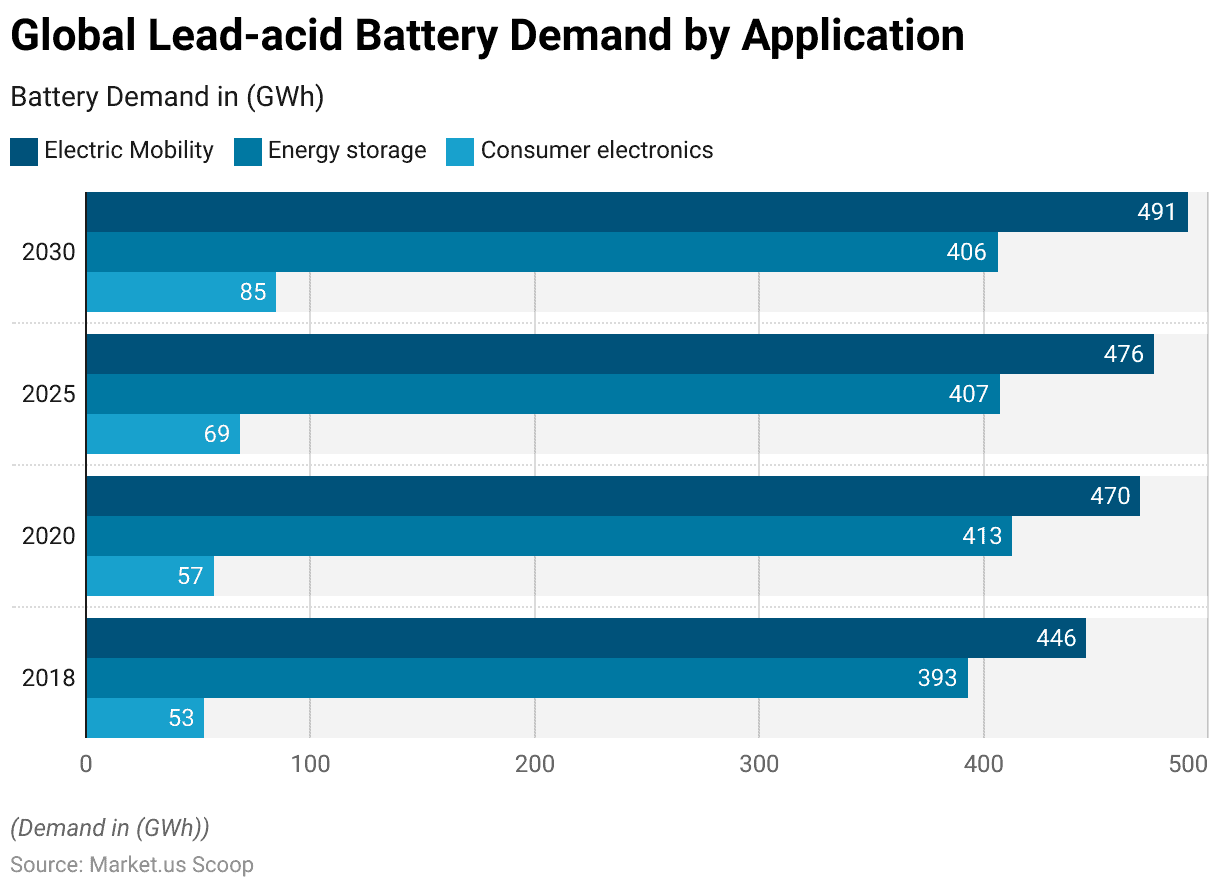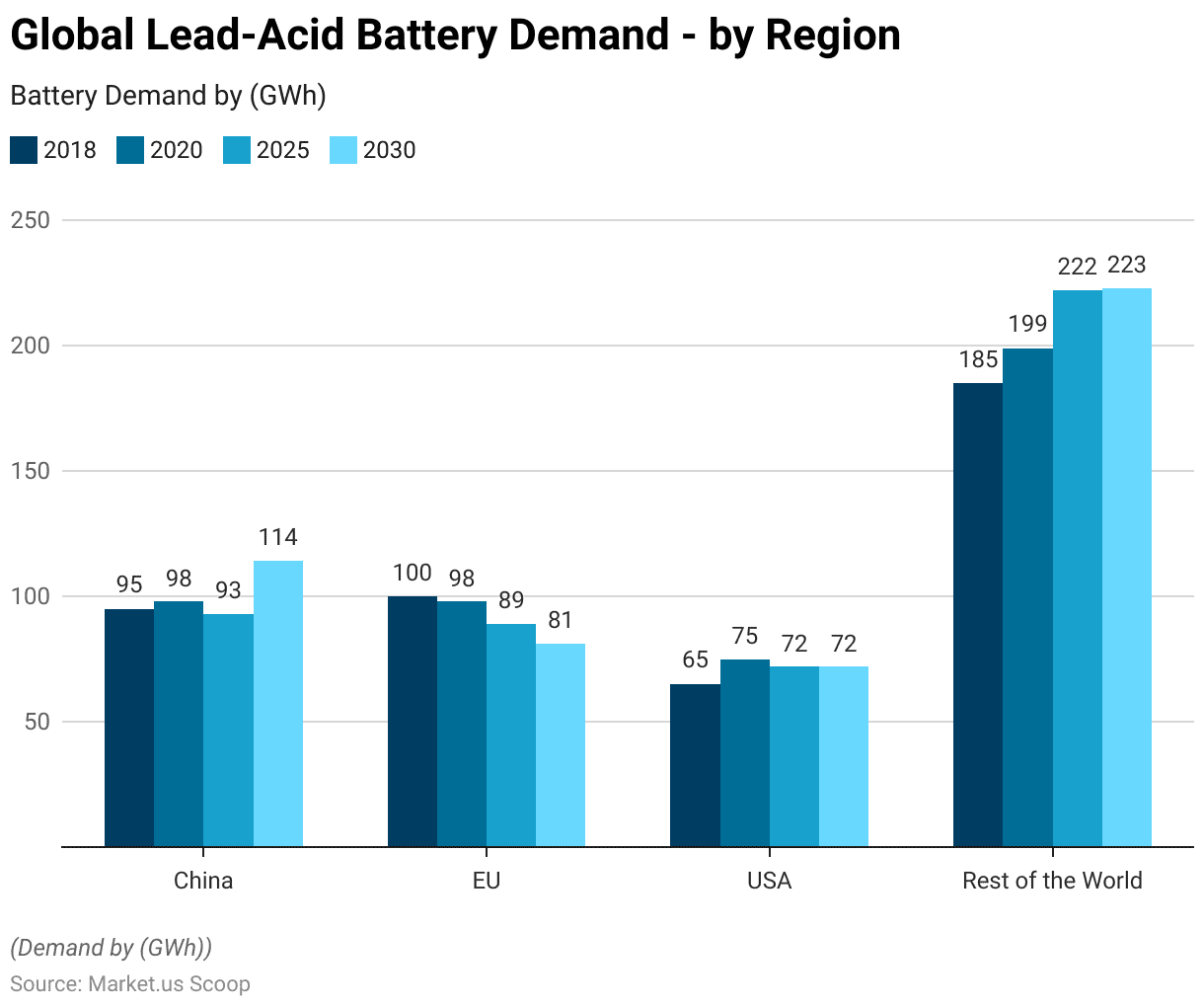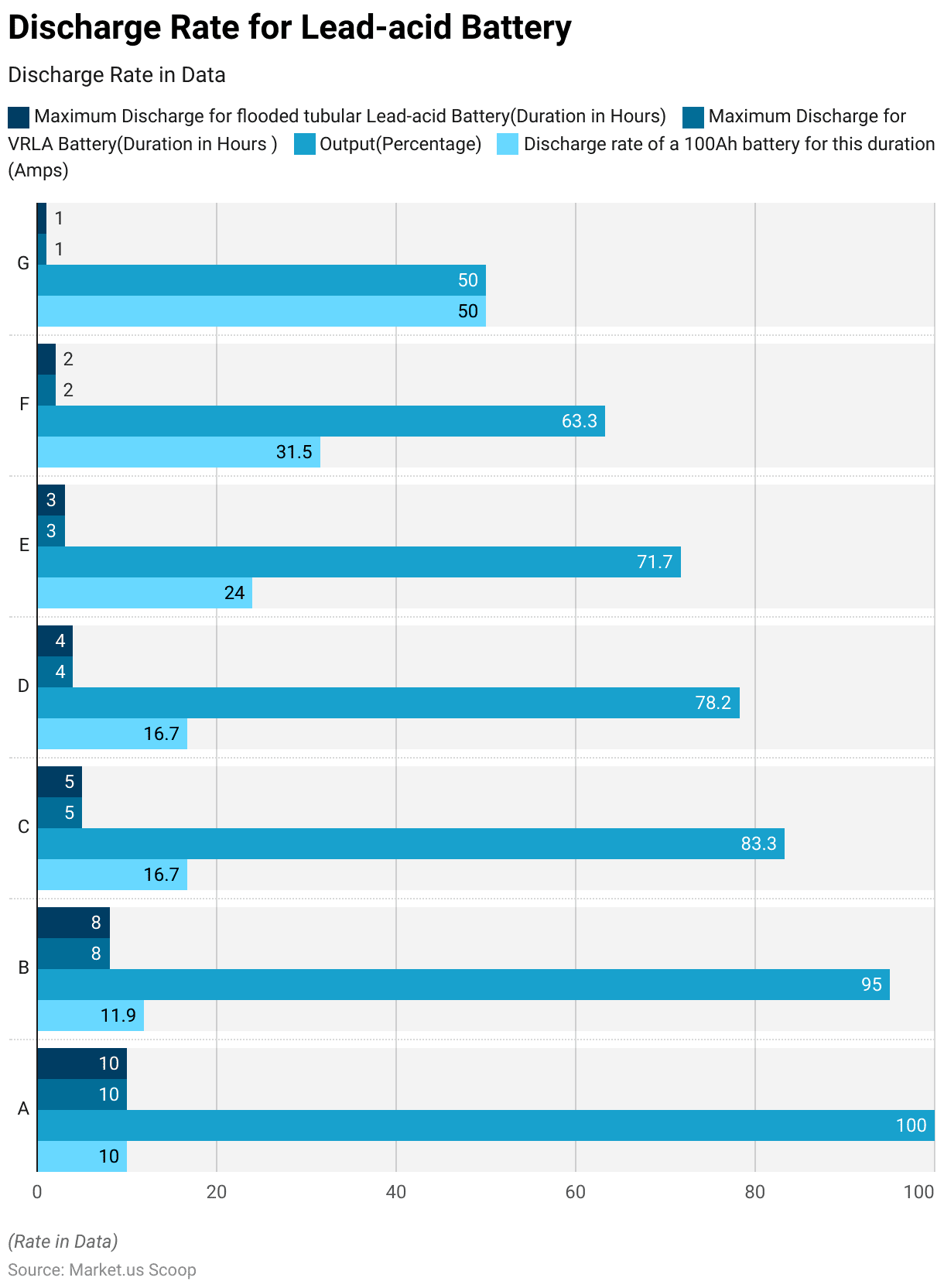Table of Contents
- Introduction
- Editor’s Choice
- Global Lead-Acid Battery Market Overview
- Specifications of Lead Acid Batteries
- Comparison of Different Types of Lead Acid Batteries and Other Batteries
- Global Lead-Acid Battery Demand
- Characteristics of Lead-Acid Batteries
- Cost of Lead-acid Batteries
- Environmental Impact of Lead-acid Batteries
- New Trends
Introduction
According to Lead Acid Battery Statistics, Lead-acid battery, among the oldest and most widely used rechargeable battery types, operate through a chemical reaction involving lead dioxide, sponge lead, and sulfuric acid in various designs, including flooded and sealed varieties like Absorbent Glass Mat (AGM) and Gel batteries. Due to their cost-effectiveness and reliability, they deliver 2 volts per cell and find application in diverse areas like automotive, uninterruptible power supplies (UPS), renewable energy storage, and telecommunications.
However, they have downsides, such as their heavy weight, limited depth of discharge, and maintenance requirements. Proper recycling is crucial to mitigate environmental concerns regarding lead pollution. Despite their enduring significance, lead-acid batteries face competition from emerging battery technologies, with ongoing research aiming to enhance their cycle life and energy density.
Editor’s Choice
- The lead-acid battery market has displayed a consistent upward trajectory at a CAGR of 6.9% over the forecasted period from 2022 to 2032.
- The lead-acid battery market revenue is expected to reach 59.0 billion USD by 2032.
- Lead-acid batteries have a nominal voltage of 2.0V per cell, and when combined in a series of 6 cells, they provide a total voltage of 12.0V.
- Projections suggest that by 2025, the lead-acid batteries demand will rise to 476 GWh, reflecting the growing use of lead-acid batteries in electric vehicles and related applications.
- Lead-acid batteries require a slow and extended charging process, typically taking 8 to 10 hours, often performed overnight for safety and efficiency.
- Manufacturers of lead-acid batteries generally assert that their products have a cycle life ranging from 400 to 550 cycles.
- Lead-acid batteries shine as environmentally responsible products, boasting an impressive recycling rate of over 97%.
- The disposal of lead-acid batteries in landfills is minimal, accounting for only 60,000 tons, or less than 0.1% of discarded municipal solid waste, as 41 states prohibit their disposal in landfills.
Global Lead-Acid Battery Market Overview
Global Lead-Acid Battery Market Size
- The lead-acid battery market has displayed a consistent upward trajectory at a CAGR of 6.9% over the forecasted period from 2022 to 2032.
- Starting at 31.0 billion USD in 2022, the market revenue has steadily grown, with subsequent years marking significant increases.
- In 2023, it reached 33.0 billion USD, followed by 35.0 billion USD in 2024, and continued to climb, reaching 38.0 billion USD in 2025.
- This upward trend persisted throughout the projection period, with revenues expected to reach 59.0 billion USD by 2032.

Specifications of Lead Acid Batteries
- Lead-acid batteries, known for their reliability and widespread use, come with specific specifications that define their performance characteristics.
- They typically have a specific energy range of 35 to 40 Wh/kg and an energy density of 80 to 90 Wh/L, reflecting their ability to store electrical energy efficiently.
- These batteries provide a specific power of around 180 W/kg, ensuring a steady release of power when needed.
- Charge and discharge efficiency can vary significantly, ranging from 50% to 95%, depending on factors like design and use case.
- Regarding cost-effectiveness, they offer an energy-to-consumer-price ratio of 7 (for sealed lead-acid) to 18 (for flooded lead-acid) Wh/US$.
Comparison of Different Types of Lead Acid Batteries and Other Batteries
- Several key characteristics stand out when comparing lead-acid, nickel-metal hydride (Ni-MH), and lithium polymer battery technologies.
- Lead-acid batteries have a nominal voltage of 2.0V per cell, and when combined in a series of 6 cells, they provide a total voltage of 12.0V.
- With a capacity of 100Ah, they offer an energy capacity of 1,200 Wh, making them suitable for various applications.
- However, lead-acid batteries are relatively heavy, weighing in at 34.3 kilograms, and occupy a significant volume of 13.4 liters.
- In contrast, Ni-MH batteries have a lower nominal voltage of 1.25V per cell, requiring ten cells in series to reach 12.5V.
Global Lead-Acid Battery Demand
Lead-acid Battery Demand by Application
- The global demand for lead-acid batteries varies significantly across different applications, showing distinct trends over the years.
- In 2018, the demand for lead-acid batteries in electric mobility was approximately 446 GWh, which increased to 470 GWh by 2020.
- Projections suggest that by 2025, the demand will rise to 476 GWh, reflecting the growing use of lead-acid batteries in electric vehicles and related applications.
- Similarly, lead-acid batteries were in demand in energy storage, with 393 GWh required in 2018 and 413 GWh in 2020.
- However, it’s worth noting that the demand is expected to plateau and remain relatively stable at 407 GWh in 2025 and 406 GWh in 2030.
- On the other hand, lead-acid batteries used in consumer electronics saw a steady increase in demand from 53 GWh in 2018 to 57 GWh in 2020, with a significant projected jump to 69 GWh by 2025 and a further increase to 85 GWh by 2030.

Global Lead-acid Battery Demand- by Region
- Global demand for lead-acid batteries varies by region, reflecting changing dynamics and needs.
- In 2018, China demonstrated the highest demand for lead-acid batteries, consuming approximately 95 GWh, slightly increasing to 98 GWh by 2020.
- However, by 2025, the demand in China decreased to 93 GWh but is expected to rebound significantly, reaching 114 GWh by 2030.
- In the European Union (EU), demand was relatively stable at 100 GWh in 2018 and 98 GWh in 2020, but it is projected to decline to 89 GWh by 2025 and further to 81 GWh by 2030.
- In the United States, demand increased from 65 GWh in 2018 to 75 GWh in 2020, and it is anticipated to remain relatively constant at 72 GWh by 2025 and 2030.
- The rest of the world, encompassing various regions, saw demand grow from 185 GWh in 2018 to 199 GWh in 2020, with further increases expected to reach 222 GWh by 2025 and 223 GWh by 2030.

Characteristics of Lead-Acid Batteries
Charging Capability
- Lead-acid batteries require a slow and extended charging process, typically taking 8 to 10 hours, often performed overnight for safety and efficiency.
- In contrast, lithium batteries can undergo a slower charging cycle of about 3 hours or even a rapid charging process, taking just an hour, without compromising their service life, charging efficiency, or safety.
- For early inventions, back in March 2011, Mitsubishi introduced two Level 3 Electric Vehicle DC Fast Charge stations in Australia, enabling a 50% charge for the i-MIEV lithium battery within 12 minutes and reaching 80% charge in just 30 minutes.
Battery Capacity
- Lead-acid batteries are typically categorized into two primary types: deep-cycle and shallow-cycle.
- Deep-cycle batteries can endure discharges of over 50%, and sometimes even as much as 80%, which allows for extended energy utilization.
- Conversely, suppose one opts for a shallow-cycle battery bank to achieve the same usable capacity. In that case, it necessitates having a larger overall capacity when compared to a deep-cycle battery bank.
Battery Life-cycle
- In the context of batteries, a cycle signifies the complete process of charging and discharging a battery. The longevity of a battery hinges on how many of these cycles it can undergo before its capacity to store and deliver energy experiences a significant decline.
- Manufacturers of lead-acid batteries generally assert that their products have a cycle life ranging from 400 to 550 cycles.
- However, when subjected to independent testing by an undisclosed manufacturer, four brands of lead-acid batteries were found to have a cycle life of only 300 to 400 cycles.
- On the other hand, E-bike manufacturers typically offer warranties that span just 1 to 1.5 years, equivalent to roughly 110 to 170 cycles.
- In contrast, Chinese manufacturers producing Lithium Ferro Phosphate (LiFePO4) batteries make bold claims regarding cycle life, touting figures of more than 2,000 to 3,000 cycles when the depth of discharge reaches 80%.
Discharge Rate
- The provided data represents the maximum discharge duration in hours for both flooded tubular Lead-acid batteries and VRLA (Valve-Regulated Lead-Acid) batteries, along with the corresponding output percentages and discharge rates for a 100Ah battery.
- For flooded tubular Lead-acid batteries, the maximum discharge durations range from 10 hours at 100% output, gradually decreasing to 1 hour at 50% output.
- Regarding discharge rates, the battery starts at 10 Amps and decreases to 1 Amp as the discharge duration extends.
- On the other hand, for VRLA batteries, the maximum discharge durations also range from 10 hours at 100% output to 1 hour at 50% output.
- However, the discharge rates for VRLA batteries are slightly higher, starting at 11.9 Amps and decreasing to 50 Amps as the discharge duration increases.

Cost of Lead-acid Batteries
- The battery cost for Lead-Acid AGM totals 60,000€, calculated at 100€ per KWh, multiplied by 100 KWh, and then multiplied by the six installations.
- In contrast, Lithium-Ion costs 20,000€, calculated at 400€ per KWh, multiplied by 50 KWh, for a single installation.
- Additionally, installation costs for Lead-Acid AGM amount to 12,000€, calculated at 2,000€ per installation, multiplied by the six installations.
- Transportation costs for Lead-Acid AGM come to 6,000€, calculated at 1,000€ per transport, multiplied by six installations. On the other hand, Lithium-Ion incurs a one-time installation cost of 2,000€ and a transportation cost of 1,000€.
Environmental Impact of Lead-acid Batteries
Benefits
- Lead-acid batteries shine as environmentally responsible products, boasting an impressive recycling rate of over 97%.
- This recycling rate outperforms other consumer goods, including aluminum soft drink and beer cans at 55%, newspapers at 45%, glass bottles at 26%, and tires at 26%.
- The secret behind the environmental success of lead-acid batteries lies in their closed-loop life cycle.
- A typical new lead-acid battery incorporates 60 to 80% recycled lead and plastic materials. When used batteries are collected, they undergo recycling at carefully regulated facilities, where the lead and plastic components are meticulously reclaimed.
Challenges
- Sealed Lead-Acid (SLA) batteries primarily consist of lead (71-76%), sulfuric acid electrolyte (16-19%), and around 8-10% other components, including the casing and vents.
- The production of batteries remains the largest lead consumer in the United States, accounting for 88% of the country’s lead consumption.
- The International Agency for Research on Cancer (IARC) and the Environmental Protection Agency (EPA) classify lead as a potential human carcinogen.
- Approximately 3 million metric tons of lead ore are mined annually, with six countries—Australia, Canada, China, Mexico, Peru, and the USA—contributing 75% of the total production.
- Lead mining has numerous ecological effects, with much of it occurring underground or near the surface, often resulting in open mine shafts.
- Around 50% of the world’s lead used in production is derived from recycling existing lead products. Developed countries, especially the USA, excel in lead recycling, with over 80% of domestic lead expenditure recovered from used batteries.
New Trends
- Recently, alternative battery technologies have gained attention, with sodium-ion (Na-ion) batteries emerging as a notable option.
- What sets Na-ion batteries apart is their reliance on more affordable materials compared to traditional Li-ion batteries, resulting in cost-effective battery production.
- Furthermore, Na-ion batteries have a distinctive advantage because they do not require critical minerals, making them the sole viable chemistry lacking lithium.
- For instance, China’s CATL has developed a Na-ion battery estimated to be 30% cheaper than a Lithium Iron Phosphate (LFP) battery.
Discuss your needs with our analyst
Please share your requirements with more details so our analyst can check if they can solve your problem(s)



